4 Negative Review Response Examples


Whether you’re brand new to operating your business online or a multi-year veteran of your industry, it’s never a pleasant experience to receive a negative review from a customer.
Did you know that you need to answer each of them? Answering reviews is a trust signal your potential customers look for before trusting you with their money.
The worst thing you can do is to ignore negative reviews and wish for the reviewer to magically delete them.
This article helps in:
- Figuring out why we tend to spring to our defenses when someone gives us negative feedback
- Keeping your cool when responding to negative reviews
- Responding successfully to different types of negative reviews
- Getting the most out of all existing online reviews
Easiest Way to Respond to Negative Reviews
Let our customer success manager Pasi tell you how to deal with bad reviews:
You might have Google reviews, but do you know how to respond to them? And were you aware that answering them can convince potential customers to buy from you in the first place?
There are many different ways to go about answering reviews on Google, but one of the easiest ways is to use reputation management software.
With a free tool like Trustmary, you can:
- Import all reviews (Google reviews, Facebook reviews, Yelp reviews, ... you name it!)
- Embed positive reviews on your website
- Collect reviews from your whole customer base
- Get more sales and leads by adding social proof to your website
- Increase the overall customer experience with the help of customer reviews
- Get better search engine rankings by adding star rating to Google
Here's how easily you could answer to both negative and positive feedback:
- Log into Trustmary
- Import reviews from all relevant sources
- Hit "reply"
- Write your review responses

Try Trustmary by typing in your Google Business location below to import all your reviews for free – and to add them to your website after answering each of them ⬇️
Negative Review Response Examples and Principles
One of the most common responses to criticism of any kind is to become defensive, to want to push back and explain that you (in your opinion) have done nothing wrong.
This is quite a natural response as our brains are wired to react to negative feedback as a kind of threat, so we naturally want to spring to our own defense.
Here's an example of a negative review...

... which received a defensive response:
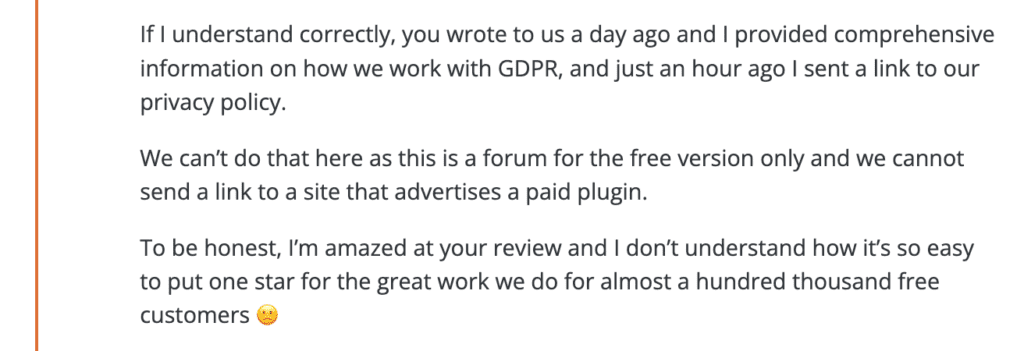
In this example, the receiver of the negative review not only gets defensive but also accuses the reviewer of bad manners.
Despite this being an understandable reaction, in the professional sphere and the world of customer reviews, pushing back against your customer and trying to defend against negative reviews is the exact opposite of what you should be doing!
Here's how I would modify the response:
"Thanks for your feedback. I apologize for the inconvenience! We take data protection and the GDPR very seriously. You can find our privacy policy here."
This way, the response addresses the reviewer's problem without getting personal or defensive.
Even though the review was quite aggressive, it's best to ignore such sentiment altogether. It might be too late to help this mad customer, but at least other people reading the response will have a better image of you.
We've written a more detailed guide for bad roofer review responses, but those strategies can be applied to other industries as well.
Responding to Negative Reviews Is Reputation Management
As you can see from the example above, responding to negative reviews is not just about restoring relationships with unhappy customers. It might even be more important to build trust with new potential customers.
We’re here to help though and guide you in the right direction with four negative review response examples you can use as a starting point for a response whenever you receive negative feedback.
First though, it’s important to keep in mind that responding to negative feedback is wrapped up in your reputation management strategy. We’ve gone into more detail here on the steps you can take to manage the customer experience, but it’s important to bear in mind how useful negative reviews can be in helping to understand your customers.
Responding to a negative review is a very public demonstration of the quality of your customer service as your response will often be online for all to see via social media or online review sites. People will be able to see exactly how much value you place in your customers when something goes wrong.
Before we look at some examples, we’ve pulled together some general guidelines outlining how you should behave when responding that will help you improve the overall customer experience.
As a result, you'll end up improving customer satisfaction and online reputation.
Don't Be Afraid of Bad Reviews
The CEO of a home improvement company, Ilkka Ahonen, celebrates negative feedback and reviews. He also answers every single one personally.
– I love it that there's bad feedback among all the open feedback. Really. I hope there are negative comments. Not everything can go right every time. We don't just want straight A's, but we also need to hear the negative experiences, because that's how we improve, Ahonen continues.
Furthermore, Ahonen thinks he needs to know what customers really think to be able to lead the company. Measuring NPS and customer experience has really enabled Balkonser's growth.
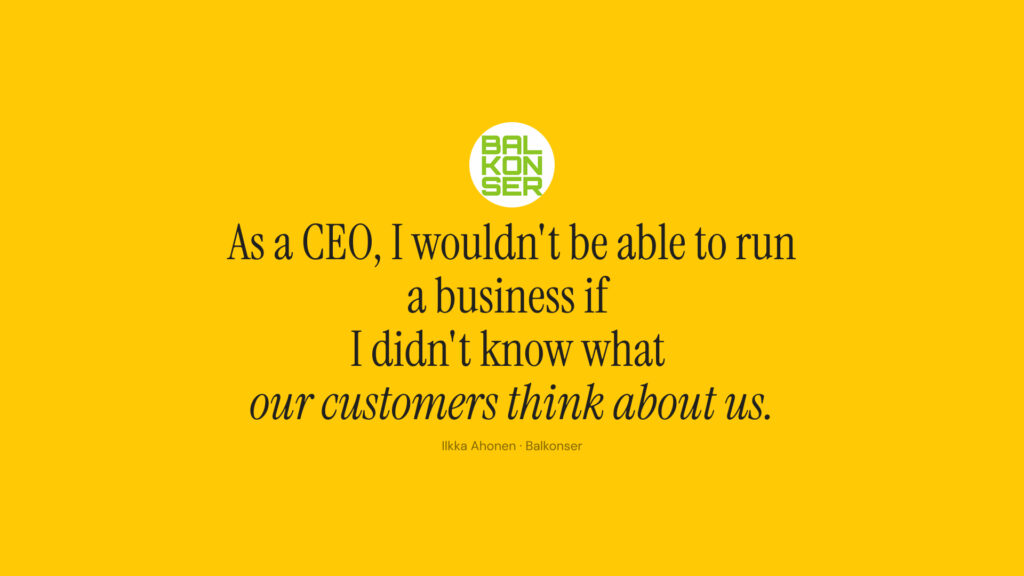
Some Dos and Don’ts When Responding to Negative Feedback
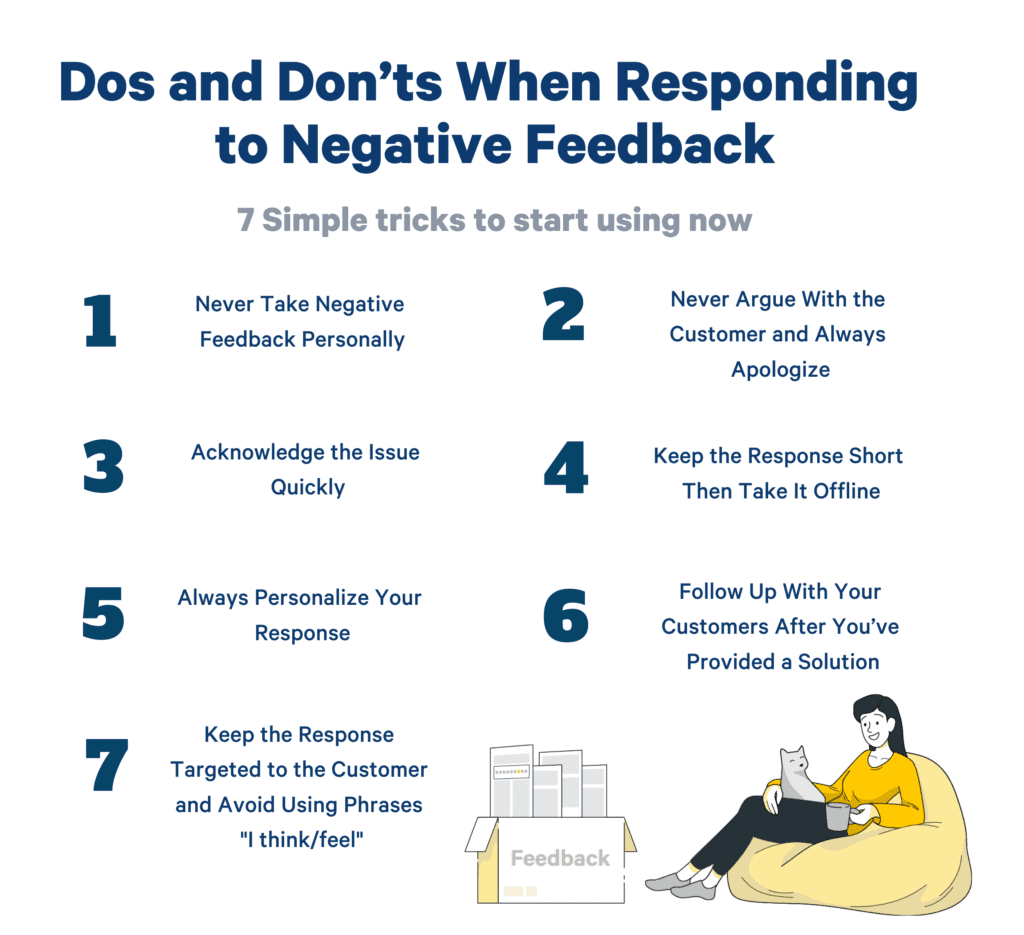
1. Never Take Negative Feedback Personally
Stay detached from the feedback and look at it objectively, separating yourself personally from the issue. This will allow you to see the problem without clouding your judgment on a solution.
If negative reviews relate to a particular member of staff, keep them at arm's length from any response. This is only so you’re able to provide an objective response.
Where you have made a genuine mistake, it’s also helpful to be transparent and acknowledge it. Don’t see it as criticism but as an opportunity to learn.
Your attitude towards a negative review should be that it's a gift: someone took time from their day to point out what you could do better next time. Appreciate this effort and learn from it.
2. Never Argue With the Customer and Always Apologize
Even if you don’t think you did anything wrong, or if it seems obvious to you at first glance that the customer is actually in the wrong, you should never argue back to them.
You can’t second guess the experience the customer had, and not only can it be difficult to get the full facts of a situation from just a short review, it also looks very unprofessional to start a slanging match with your customers online.
You risk alienating other customers who will be watching your behaviour who may then decide you’re not the nicest of organizations to be dealing with and move swiftly on to one of your competitors.
Instead apologize straight away. This lets the customer know you’re willing to take their complaint seriously and gives you a chance to pull together all of the facts before providing a tailored solution to their problem.
Even if you find out later that the complaint wasn’t legitimate or was the result of trolling, at least you’ve done the professional and courteous thing and tried to help where you could.

3. Acknowledge the Issue Quickly
Responding to negative reviews can be a bit of a race against time given we’re in an increasingly technology-reliant and fast-paced world. A survey found that 78% of people who complained via social expected a response within just one hour and those complaining via other avenues usually expect a quick turnaround time of about 24-48 hours.
Another review statistic shows that one-third of customers expect a response to their negative review within 3 days.
The consequences of ignoring negative feedback can be to give the impression that you simply don’t care or are just too busy to notice. Either way, your customers will take note and move on to a competitor who has better engagement with their customers.
If you don't believe me, believe facts. The top 10% of brands respond to online reviews much faster than other brands.
Is it a coincidence? Don't think so.
4. Keep the Response Short – Take the Conversation Offline
You don’t want to go into too much detail in your initial response. The first response is often public in nature, either via social media or review aggregation sites. You don’t want to air all of the details for the whole world to see.
Once you’ve given your initial response (ideally using one of our negative review response examples below), guide the customer into other avenues for final resolution of their complaint.
It’s going to be a very rare event when you can reach a satisfactory conclusion from that initial conversation. Offer the customer the option to reach you
- with a direct message (Facebook, IG)
- via customer service
- via email or
- phone call
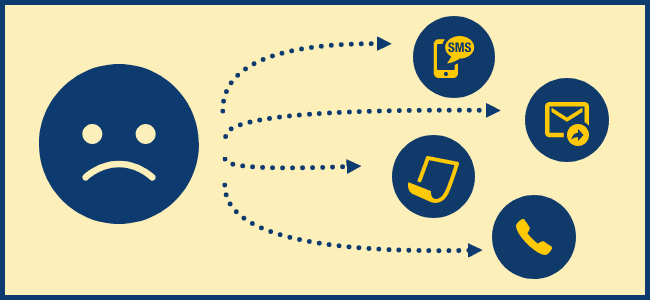
This way, you offer them a choice of what is the most convenient way for them so you can follow up and investigate the complaint in more detail.
This also has the added bonus of adding a personal touch to your response. It gives the customer the chance to chat with an actual human being instead of what can often be perceived as a faceless corporation.
Taking the conversation offline will most probably result in a positive outcome, as none of the parties involved need to risk losing their face in the internet.
5. Always Personalize Your Response
Always address the customer by name and be varied in your responses. Customers can easily spot when you have a generic response that’s just cut and pasted from one bad review to the next.
While we definitely recommend using one of our response examples as a starting point, try not to copy them word for word for every single complaint.
Look at what the customer is saying and try and make reference to their specific issue.
Use the customer's name and try to understand their point of view, and craft your message accordingly.
6. Follow Up
Try and stay in touch with the customer after you’ve resolved their complaint. Following up with them a couple of weeks after you’ve dealt with their complaint can add some additional impact to the original resolution.
Some customers don’t even expect any response to their feedback at all, so it can often be a welcome surprise when someone checks in on them to see how they’re doing.
When done right, a good follow up could lead the customer to end up actually promoting you both online and offline.
In addition, when you've made sure the unhappy customer is now happy, you should ask them for a testimonial. These people are very likely to write you glowing reviews. After all, you were able to solve their issues.
Get inspired by these three best examples of testimonial request letters and have a look at this great simple review request template below ⬇️
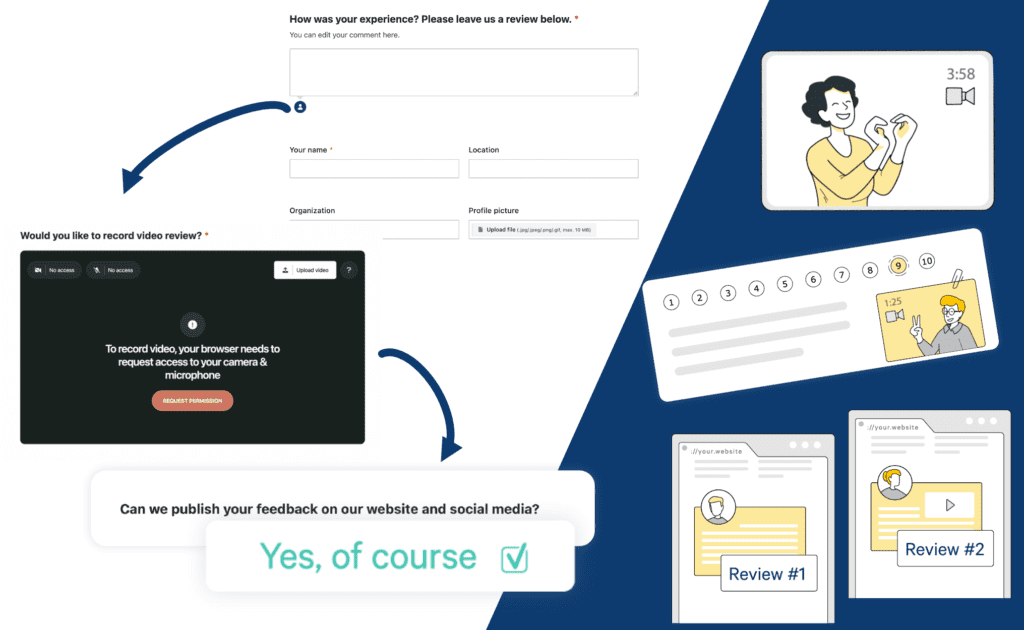
7. Keep the Response Targeted to the Customer and Cut Certain Phrases
Don’t use phrases like “I think” or “I feel” in your response.
It’s impossible for you to know the exact experience your unhappy customers have just had.
It's best to avoid stating opinions or making your own assumptions with a detailed response. Make it all about the customer and acknowledge they have an issue. Make them feel heard and seen!
4 Negative Review Response Templates to Try
This is what you came here for, so here you go: a collection of templates on how to respond to negative online reviews.
We have crafted an example for different scenarios so that you can pick the right one and modify it to your purpose.
1. Try to Resolve Issue, Contact Details Unknown - Example
Hi [Name],
Thank you for leaving your feedback. We strive incredibly hard here to make every customer experience enjoyable and we’re really sorry we’ve not been able to meet your expectations this time.
We’d love to resolve this as quickly as possible and find a solution that works for you.
Please drop us a message directly via this email [email address] and we’d love to talk more!
[Name - optional]
2. Try to Resolve Issue, Contact Details Known - Example
Hi [Name],
I’m [Name], and I’m the Head of Customer Service here. We’re ordinarily known for our exemplary customer experience here. We hope you accept our sincerest apologies for your recent experience with us.
We have your contact details and will be in touch as soon as possible to try and make things right. If it’s more convenient for you, please get in touch with me personally at [phone/email] and I’ll do my utmost to resolve your issues.
Sincerely
[Name, Business name]
3. Ask for More Information - Example
Hi [Name],
Thank you for your review. All feedback is important to us and we’re sorry to hear you’ve had such a frustrating experience.
As you can hopefully see from our other reviews, your situation is the exception and far from our usual high standards and company's values. This makes us all the more keen to make sure this gets resolved and doesn’t happen again.
Drop our support team a message at [email/phone] to let them know all the details and we promise you we’ll tailor a satisfactory resolution for you.
Sincerely
[Name, business name]
4. Arrange Phone Call - Example
Hi [Name],
Thank you so much for bringing this issue to our attention. First off, let me apologize for the unacceptable way in which you’ve been treated.
Keeping our customers happy is our number one priority and I’d like to ask you for another chance to make this up to you.
Please give me a call at [phone number] at any time or we can reach out to you at a time convenient for you.
Sincerely
[Name - title (for example, General Manager, CEO, ...)]

Business Owner: Respond to Negative Reviews
Remember, these are just some samples to get you started. Each complaint is going to be slightly different depending on the circumstances, so you’ll have to make a judgement call on a case by case basis on exactly what to write.
We’d also recommend not signing off your response with your company name. There’s a chance Google could pick this up and the complaint ends up in search engine results. Seeing first up in search results what your angry customer think isn't really the thing that improves your conversion rates.
Amazingly, research shows that 72% of customers won’t take action on a product or service until they’ve read a review. If they see a long list of negative reviews with no responses at all, they’ll definitely start to lose trust.
This is why it’s essential to respond to all of your negative customer feedback. Every single unhappy customer can potentially be retained and presents you the opportunity to improve.
I'm sure some of you have one question: what to do if someone id purposefully harassing my business with fake bad reviews?
Usually, responding to negative reviews is enough to soothe an unhappy customer and signal to others that you take customer experience seriously. However, if someone is bombarding you with dishonest negative comments in order to harm your business, you might have to employ tougher measures. For example, a letter of demand is one of the last resorts you can turn to.
Benefits of Answering to Online Reviews
- Chance to retain a customer
- Opportunity to improve business
- Better reputation management
- Most importantly, your responses tell the world exactly how you treat your customers.
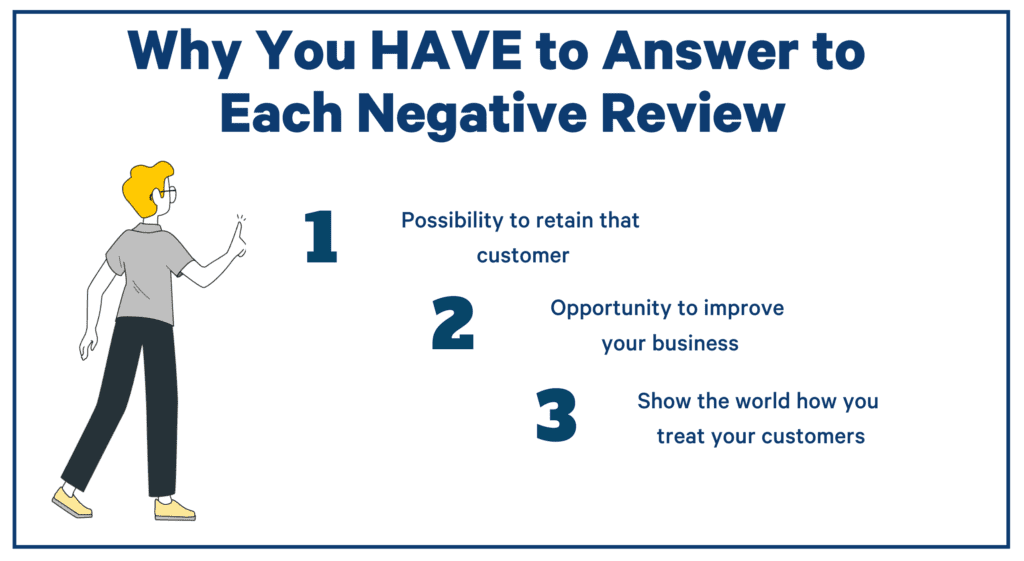
Did you know that you should respond to all positive reviews as well?
Collect More Reviews to Counter for the Negative
The easiest way to counter the effects of a few negative reviews is actually to collect new reviews.
Think about it: Getting a handful of new reviews will push that negative review further down so that it isn't among the most recent anymore.
Then, you can focus on improving the overall star rating by getting more 5-star reviews.
Start a Review Campaign
Setting up a review campaign has never been easier.
Just type your Google My Business location below and set it up.
There are only a few simple steps to take. And you can even avoid negative reviews!
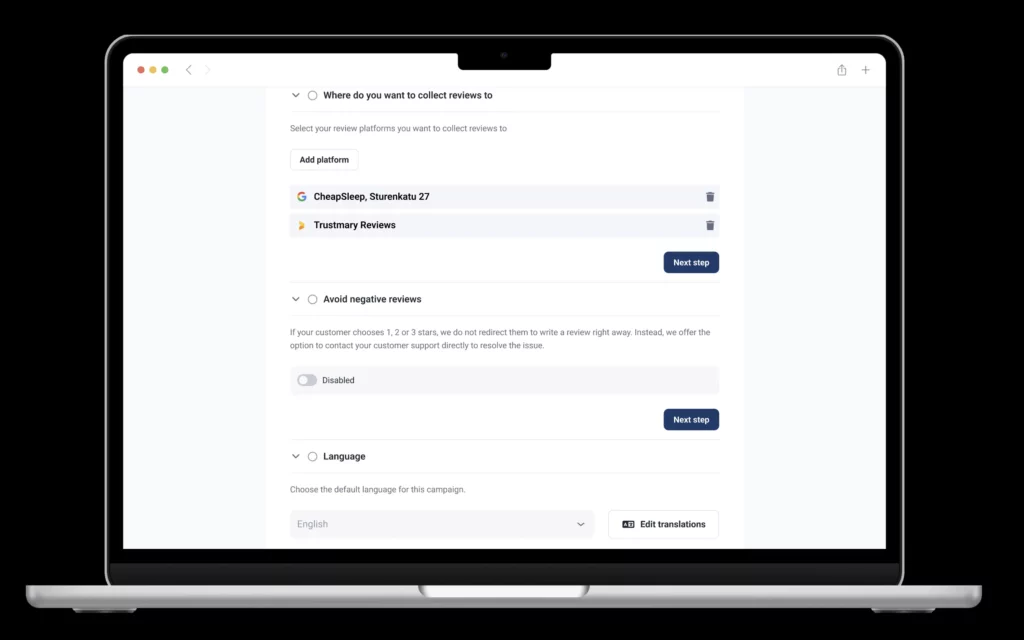
Showcase All Reviews on Your Website
Since you are here, you might already have some negative online reviews and are looking for a solution to fix your reputation.
Well, you probably also have positive reviews, isn't that true?
Even if you have negative reviews, it takes nothing away from your positive reviews. They are still as valuable as ever! You should make the most out of them.
The best way to do it is to import your positive reviews from external review sites and display them on your website. This way, you can take back the control and put your best face forward for your website visitors.
Trustmary can do it for you. Import reviews from these sites:
When you import the reviews, Trustmary creates a stylish widget and automatically prioritizes your most attractive reviews!
What does this cost, you might ask?
Nothing, it's free. No binding terms, no fixed contracts.
What stops you from adding reviews to your website right now?
Benefits of Having Reviews Embedded to Website
There are many benefits to having positive reviews embedded to your own site.
Here are a few results from our customers:
- 37% more sales with a review pop-Up
- 8% more registrations with video reviews vs text reviews
- 60% increase in contact requests
Overall, simply adding reviews to your own website can have a huge impact on your overall conversion rates.
FAQ
What are bad reviews?
Bad online reviews are usually posted either in closed groups or openly on third party review sites. These are then left for your potential customers to find. Ouch.
Luckily, you can turn the situation to your advantage by answering to all customer feedback in a timely manner. This showcases that you care about your customers and are willing to improve the way you operate.
How do I respond to a rude review?
It's always a good idea to start with apologizing. After all, people want to feel heard and understood.
Here's a short formula for small businesses to corporations:
- Don't use a copy-paste answer
- Respond quickly (within 48 hours)
- Address the person by name
- Thank for letting you know
- Apologize (Sorry to hear) & don't put blame on the customer
- Explain how you'll do better next time
- Take things offline
- Fix the issues
How to turn negative reviews into positive reviews?
If you react to all negative reviews promptly and fix the issues mentioned, you'll be able to turn around the overall feel of what is said about you online.
Once you've fixed the issues mentioned, remember to request for a new review.
"Please let us know how well we were able to serve you today! Your feedback is highly appreciated and helps us do better next time ❤️"
You won't believe how many people will become your most loyal customers, once you've been able to meet expectations after failing them once.
